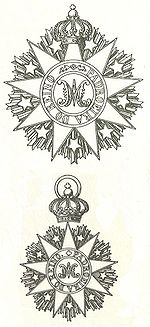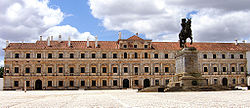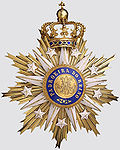- Order of the Immaculate Conception of Vila Viçosa
-
The Order of the Immaculate Conception of Vila Viçosa (also known as The Order of Our Lady of Conception of Vila Vicosa) is an dynastic order of knighthood of the House of Braganza, the former Portuguese Royal Family. The current Grand Master of the Order is Duarte Pio, Duke of Braganza, the Head of the House of Braganza.
Contents
History
The order was created by King John VI of Portugal in Rio de Janeiro on 6 February 1818, the date of his acclamation, in recognition for the efficient protection of the Kingdom's Spiritual Sovereign (Portugal is known as the Land of Santa Maria since its foundation). The Blessed Virgin Mother under the invocation of the Immmaculate Conception (venerated in the Ducal Chapel of the Palace of Vila Viçosa) had earlier been acclaimed "Queen" and Patroness of the kingdom by King John IV on March 25, 1646 following a referendum of the Empire that lasted 6 years and asked subjects: 1. If they believed the Blessed Virgin Mary to have been conceived without sin, and 2. If they believed that the Blessed Virgin Mary was the physical reigning Queen of Portugal and not just symbolically the Patroness. The people answered affirmatively and since the Coronation that took place at Vila Viçosa, the Kings of Portugal never again wore a crown.
This order distinguished those who proved their loyalty to the Portuguese Royal House in the war against the Bonapartist occupying forces.
Later, in 1818, a royal decree stated that the Order would be given as a military award in four (4) classes of Grand Cross, Commander, Knight, and Servant. Knighthood was given to those who were servants to the king and devoted Catholics to the pope and the Holy Mother.
The Order was originally limited to twelve Grand Crosses, forty Commanders and one hundred Knights, with the provision for the award of supernumerary Grand Crosses.
Grand Crosses were usually given to higher nobles who had positions in the Royal Household. Lower grades (Commander and below) were granted to lesser nobles who had provided personal service to the King.
Unlike the earlier Religious-Military Orders, the Order of Christ, the Order of St. Benedict of Aviz, and the Order of St. James of the Sword, Vila Viçosa was more aligned to the Order of the Tower and Sword which had been established by King John VI.
Much of the era of the 19th century was concerned with the right of royal succession in Portugal. Much of this data is available in Mr. Guy Stair Sainty's World Orders of Knighthood and Merit. Late into the 19th century, the constitutional sovereigns were inclined to treat the Order of Vila Viçosa as the paramount award given by the Duke for services rendered to the Royal House.
In 1910, a revolution installed a Republican government that took over all State Orders; however King Manuel II of Portugal in exile and after his death the Dukes of Braganza continued to use the order's insignia and to bestow it just the same, as it was always considered first and foremost a House Order and not a State one. In fact, just after the Second World War, it was bestowed on Prime Minister António de Oliveira Salazar by Queen Amelia when she visited Portugal for the last time.
In December 1983, Duarte Pio, Duke of Braganza, godson of Pope Pius XII, re-activated the Order of the Immaculate Conception of Vila Viçosa, and maintains it as an honorific dynastic order of the Portuguese Royal Family. He has since then distinguished many Portuguese personalities (among them soccer stars Cristiano Ronaldo and Luis Figo).
Unlike many former royals of Europe, the Duke of Braganza is loved by most Portuguese.[citation needed] This is due in part to the help of the Portuguese monarchy which allowed for Portugal to remain independent from Spanish reign, advances in trading and commercial responsibilities with other countries, the beautification of Lisbon, and the Duke's desire not to be involved in Portuguese government.
On 13 May 1995, Dom Duarte's marriage to Portuguese noblewoman Dona Isabel de Heredia was carried over most of the Portuguese and international television channels including CNN, Fox, and MSNBC.
According to RISMA Vice-Chancellor and Secretary General Carlos Evaristo, C.V.V., the Order is primarily bestowed upon Portuguese nobles, and only occasionally out of protocol on Heads of State and Royal Houses, but has also been bestowed (before 2005) on foreign and Portuguese recipients who received it solely as an honorary award for services rendered to the expansion of the Cult of the Blessed Virgin Mary, the Message of Fátima, or the Catholic Church, but who are not listed as active members of the Portuguese Order and therefore not invited to attend functions or events organized by the Order.
Honorary Members are also not expected to contribute with yearly dues or contributions, although they may wear the decorations at public events if they solicit and obtain permission beforehand to do so from the Secretariat of the Royal House.
Distinguished Knights
- Infante Juan, Count of Barcelona (father to the present king of Spain)
- King Juan Carlos I of Spain
- His Royal Highness the Infante of Spain Don Carlos of Bourbon-Two Sicilies & Bourbon-Parma, Duke of Calabria, Count of Caserta;
- Archduke Otto von Habsburg of Austria, head of the Imperial House of Habsburg-Lothringen
- Crown Prince Alexander of Yugoslavia
- Vittorio Emanuele, Prince of Naples;
- Dom Miguel, Duke of Viseu
- Infante Henrique, Duke of Coimbra
- Brazilian senator Rodrigo Augusto da Silva
- Luis Fernando da Gama Pimenta de Castro Damasio;
- Helder Diegues Cerqueira de Souza;
- Costinha, former professional footballer and Sporting's Director of Football.
- John Brinsmead, 19th century English piano maker
Insignia
The order's insignia was designed by the French painter Jean-Baptiste Debret (1768–1848), who was in charge of creating in Rio de Janeiro an arts and crafts lyceum (Escola Real de Artes e Ofícios) under the auspices of King D. João VI and the Marquis of Marialva. The order's sash is light blue and white. The medallion is starshaped and crowned, and in it center has a monogram with the letters "AM". Surrounding the monogram there is an inscription saying "Padroeira do Reino".
The Order is unofficially acknowledged by the Portuguese government. It may be worn by Portuguese citizens, but not on Portuguese military uniforms.
See also
References
- "COMMISSIONE INTERNAZIONALE PERMANENTE PER LO STUDIO DEGLI ORDINI CAVALLERESCHI," Registro degli Ordini Cavallereschi: relazione della Commissione internazionale permanente per lo studio degli Ordini Cavallereschi. Edited by Prof. Pier Felice degli Uberti. Bologna, 2001–2006.
- Evaristo, Carlos. "Il Reale Ordine de Nostra Signora della Concezione Immacolata di Villavicosa". degli Uberti, Pier Felice. And Maria Loredana Pinott (Eds.). Agigento 16–18 Novembre 2007. Convegno Internazionale “Storia, funzione, valori e attualita degli Ordini Cavallereschi e di Merito: I sistemi premiali nel Mondo e nell’Italia pre-unitaria sino al moderno Stato federalista.” International Commission for orders of Chivalry (ICOC). pp. 236–38.
- Evaristo, Carlos. 'Il Reale Ordine di Nostra Signora della Concezione Immacolata di Vila Viçosa". Il Reale Ordine di San Michele dell’Ala. Sommario n° 28 – ottobre-dicembre 2007. Il Mondo del Cavaliere Rivista Internazionale sugli Ordini Cavallereschi. pp, 103–111.
- Evaristo, Carlos. Gli Ordini Portoghesi Della Casa Di Braganza: Evoluzione Storica. Ed Attualita pp 227–240.
- Montells y Galan, Jose Maria de and Escudero y Diaz-Madronero, Alfredo . 2006. Orden de la Immaculada Concepcion de Nuestra Senora de la Viçosa. Tesoro Ecuestre: Las Ordenes Dinasticas de Caballeria. Sociedad Heraldica Espanola, pp. 80–81.
- Sainty, Guy Stair. 2006. "The Order of Our Lady of the Conception of Vila Viçosa". World Orders of Knighthood & Merit. Guy Stair Sainty (editor) and Rafal Heydel-Mankoo (deputy editor). United Kingdom: Burke's Peerage & Gentry. 2 Vol. (2100 pp). pp. 694–700.
- Secretariado de Estado da Cultura. Tesouros Reais. Lisbon: Textype – Artes Gráficas, Ld.ª, 1992. ISBN 972-9496-12-9.
- Van Duren, Peter Bander. 1985. Orders of Knighthood and of Merit, Gerrads Cross, Colin-Smythe.
External links
- THE ORDER OF OUR LADY OF THE CONCEPTION OF VILA VIÇOSA by Guy Stair Sainty
- International Commission for Orders of Chivalry (dynastic orders section). The Commission's president is Prof. Dr. Pier Felice degli Uberti of Italy.
- Royal Dynastic Orders of Portugal[dead link]
Categories:- History of Portugal
- Orders of the House of Braganza
- Order of the Immaculate Conception of Vila Viçosa
Wikimedia Foundation. 2010.



